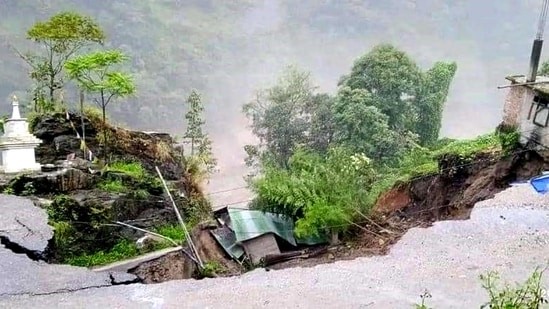Description

Disclaimer: Copyright infringement not intended.
Context
- Recent flash floods in north Sikkim resulted from the bursting of the South Lhonak Lake.
- Ten casualties reported, and many are missing due to incessant rains and rising water levels in the Teesta River.
- The South Lhonak Lake had been under scrutiny for its rapid expansion and susceptibility to Glacial Lake Outburst Floods (GLOF).
Details
What is GLOF?
- Glacial lakes, like South Lhonak Lake, form in front of, on, or beneath melting glaciers.
- As they grow, they become more dangerous, often dammed by unstable ice or sediment.
- If the dam breaks, massive volumes of water rush downstream, causing floods known as GLOF.
- GLOF can be triggered by earthquakes, heavy rains, ice avalanches, or landslides.
Factors Contributing to GLOF
- Glacial lakes are common in steep, mountainous regions, making them vulnerable to landslides or ice avalanches that displace water.
- The impact of climate change leads to rapid glacier melting, resulting in the formation and expansion of glacial lakes.
- In Sikkim Himalayan, rising temperatures have caused glacier melt, leading to the proliferation of glacial lakes, including the South Lhonak Lake.
- There are over 300 glacial lakes in Sikkim Himalayan, with 10 identified as vulnerable to GLOF.

South Lhonak Lake's Susceptibility to GLOF
- South Lhonak Lake had shown significant growth over the past five decades.
- An earthquake in 1991 and another in 2011, along with future seismic events, were identified as potential triggers for GLOF.
- Government authorities had been monitoring the lake's expansion and susceptibility to GLOF.
Government Action to Tackle South Lhonak Lake's Expansion
- In 2016, authorities, including the Sikkim State Disaster Management Authority and Sikkim's Department of Science and Technology and Climate Change, initiated measures to address the expanding South Lhonak Lake.
- Innovator Sonam Wangchuk supervised the implementation of a technique involving the syphoning off of lake water.
- Three eight-inch wide and 130-140 meters long High-Density Polyethylene (HDPE) pipes were installed in the lake to remove water at a rate of 150 liters per second.
Lhonak Lake and the Chungthang Dam in Sikkim
Lhonak Lake
- Lhonak Lake is a glacial lake situated in the pristine landscapes of North Sikkim, at a staggering altitude of approximately 17,000 feet above sea level. Its formation is attributed to the melting glaciers of the region, a process accelerated by rising global temperatures.
- South Lhonak Lake is a glacial-moraine-dammed lake, located in Sikkim's far northwestern region.
- It is one of the fastest expanding lakes in the Sikkim Himalaya region, and one of the 14 potentially dangerous lakes susceptible to Glacial lake outburst flood (GLOFs).
- It plays a role in the hydrological cycle, releasing water downstream, ultimately benefiting the Teesta River basin.
Chungthang Dam
- Hydroelectric Power Generation: The dam serves as a hydroelectric power generation facility, contributing to Sikkim's renewable energy portfolio.
- Water Resource Management: By regulating the flow of the Teesta River, the Chungthang Dam plays a crucial role in irrigation, drinking water supply, and flood control.
- Environmental Impact: While the dam offers valuable benefits, its construction and operation also raise environmental concerns, including alterations in river ecosystems.
.jpg)
Conclusion
- GLOF events, like the one at South Lhonak Lake, pose significant risks to downstream areas.
- Climate change-induced glacier melt leads to the formation and growth of glacial lakes.
- Monitoring and proactive measures by government authorities are crucial in mitigating the impact of GLOF events and safeguarding vulnerable regions.
|
PRACTICE QUESTION
Q. Glacial Lake Outburst Floods (GLOF) have become a significant concern in the Himalayan region. Discuss the factors contributing to the occurrence of GLOF events and their potential impacts on the local communities and the environment. Also, analyze the measures that can be taken to mitigate the risks associated with GLOF in the Himalayan region. (250 Words)
|
















